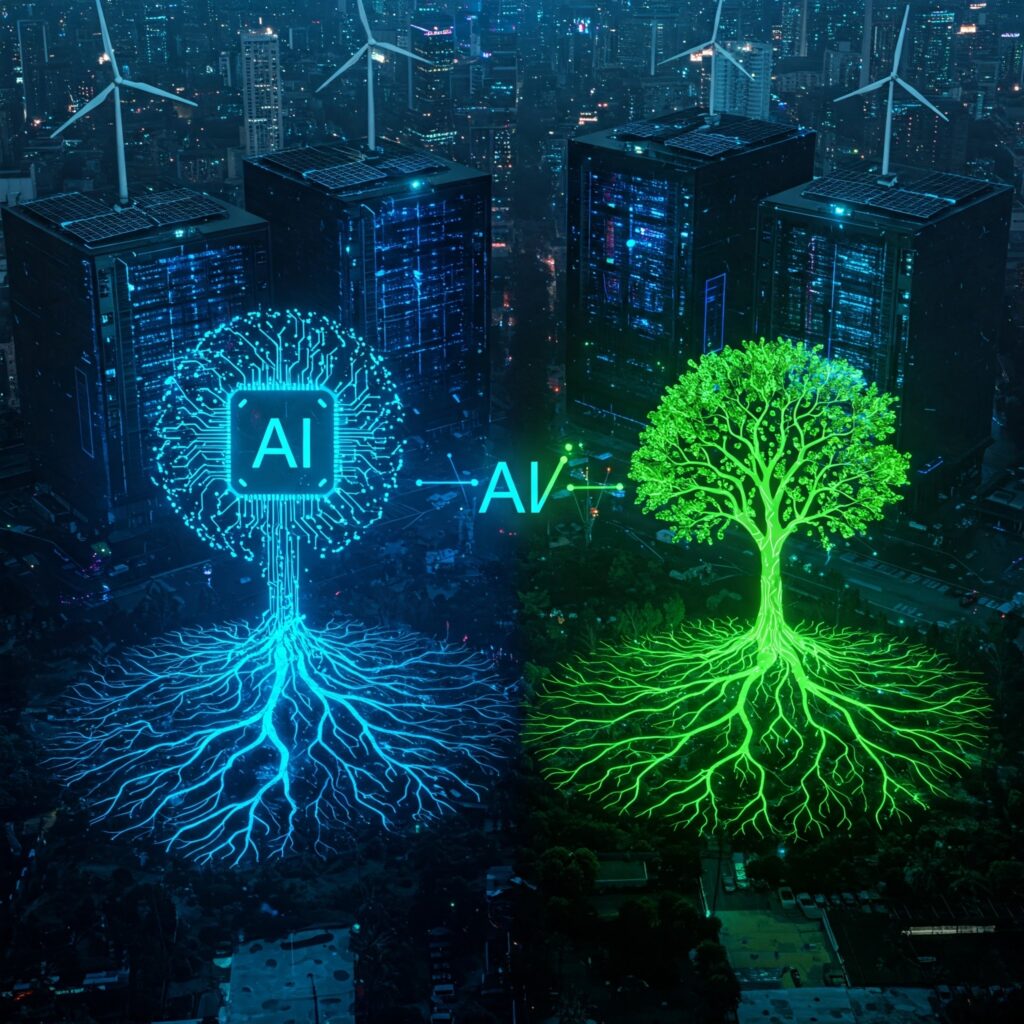Powering the Digital Age: The Unintended Consequences of Data Centers, AI, and Mobile Apps
You won’t believe the hidden monsters consuming the energy behind your online activities! Behind the sleek interfaces and seamless user experiences lies a shocking reality: staggering energy consumption, environmental degradation, and a ticking time bomb threatening our digital world’s very foundation. As we rush to find sustainable solutions, it’s crucial we understand the vital role of data center infrastructure in a rapidly evolving technology landscape that holds both transformative promise and devastating risks for our planet.
Forget sleek server racks and blinking lights; imagine a roaring, power-hungry beast, constantly fed with data, demanding ever-increasing amounts of electricity. This isn’t science fiction; it’s the reality of the AI-driven data center boom, a phenomenon reshaping our digital landscape and pushing our planet to its limits.
The insatiable appetite of Artificial Intelligence (AI) is at the heart of this energy crisis. Every time you ask a chatbot a question, stream a 4K video, or train a complex machine learning model, you’re contributing to a massive surge in data processing. These operations, crucial for modern tech, demand the constant movement of colossal data volumes between servers and even geographically distant data centers. But this data movement isn’t free; it comes with a hefty energy price tag.
Think of it as a digital highway, but instead of cars, it’s data packets flowing at the speed of light. This relentless traffic requires immense processing power, leading to increases in heat generation. To keep these digital engines from melting down,Data centers deploy sophisticated cooling systems (such as liquid cooling, air-side economization, and evaporative cooling), further amplifying their energy consumption. This creates a vicious cycle: more AI, more data, more power, and more heat.
The physical demands are staggering. We’re talking about power grids straining to their limits, cooling systems battling against the relentless heat, and a growing environmental footprint that can’t be ignored. The race to interconnect AI data centers, essential for distributed training and real-time AI applications, only exacerbates these challenges. High-bandwidth, low-latency connections, while crucial for performance, demand even more energy.
This isn’t just a technical problem; it’s an environmental and societal one. The sustainability of our digital future hinges on finding innovative solutions to curb this energy consumption. Liquid cooling, renewable energy sources, and AI-driven network optimization are all part of the answer. But the clock is ticking.
Diving Deeper into the Technical Demands:
The sheer volume of data being moved and processed in AI data centers is unprecedented. Training large language models, for instance, involves manipulating datasets that can reach petabytes in size. This data isn’t just stored; it’s constantly being accessed, transformed, and transferred between processing units. The GPUs and TPUs powering these operations are incredibly power-intensive, generating heat that requires substantial cooling.
The interconnectivity of AI data centers adds another layer of complexity. Technologies like optical fiber and coherent optics are essential for achieving the required bandwidth and low latency. However, these technologies also consume significant power, particularly when transmitting data over long distances. Data Center Interconnect (DCI) solutions, while crucial for enabling distributed AI processing, contribute to the overall energy footprint.
Furthermore, the shift towards edge computing, where AI inference is performed closer to the end-user, introduces new challenges. While edge computing reduces latency and bandwidth demands on core data centers, it also necessitates deploying smaller, more distributed data centers, potentially increasing the overall energy consumption.
The Environmental Impact: Beyond Power Consumption:
The energy consumption of AI data centers has a significant environmental impact. The majority of data centers rely on electricity generated from fossil fuels, contributing to greenhouse gas emissions and climate change. The carbon footprint of AI is a growing concern, as the demand for AI applications continues to rise. Consider this: a single, large-scale AI training run can consume as much energy as several households over a year, with some estimates reaching hundreds of megawatt-hours (MWh) for complex models. That’s equivalent to the electricity used by dozens of homes, just for one training session. The global data center industry, a significant portion of which is now dedicated to AI workloads, is estimated to consume about 1% of the world’s electricity. This might sound small, but when you consider that global electricity consumption is measured in terawatt-hours (TWh), that 1% represents a massive amount of power – thousands of TWh. Some estimates suggest that the energy consumption of AI could increase by 50 times by 2030, potentially pushing data center energy use into the double-digit percentages of global electricity demand.
Beyond greenhouse gas emissions, data centers also consume significant amounts of water for cooling. Traditional air-cooling systems evaporate water, contributing to water scarcity in some regions. Liquid cooling systems, while more efficient in terms of energy consumption, also require water for heat exchange. To cool a data center with tens of thousands of servers, millions of gallons of water can be evaporated annually. Even liquid cooling, which is more energy efficient, can use thousands of gallons per day, depending on the scale of the facility. Data centers generate significant heat, requiring substantial cooling infrastructure. For example, a modern AI data center can generate heat loads in the hundreds of kilowatts per rack, demanding cooling systems that can handle thermal dissipation on a megawatt scale.
The disposal of electronic waste, or e-waste, is another environmental concern. Data centers generate large amounts of e-waste, including servers, storage devices, and networking equipment. Improper disposal of e-waste can lead to soil and water contamination, posing risks to human health and the environment. A single hyperscale data center can generate thousands of tons of e-waste every few years, as components are upgraded or replaced. E-waste from data centers contains valuable metals such as copper and gold, but also hazardous materials like lead and mercury. For example, a typical server motherboard contains several grams of gold, but also potentially harmful levels of lead and cadmium. The rapid growth of AI is driving a surge in demand for rare earth metals, which are essential for many AI hardware components, with some high-performance GPUs requiring several kilograms of these rare materials
Seeking Sustainable Solutions:
Addressing the energy and environmental challenges of AI data centers requires a multi-faceted approach. One promising solution is the adoption of renewable energy sources, such as solar and wind power. Data centers can also improve their energy efficiency by implementing advanced cooling technologies, such as liquid cooling and free cooling.
AI itself can play a role in optimizing data center operations. Machine learning algorithms can be used to predict and manage energy consumption, optimize cooling systems, and reduce waste. AI-driven network optimization can also help reduce data traffic and improve bandwidth utilization.
Furthermore, the design and construction of data centers can be made more sustainable. Building materials with lower environmental impact, and designs that maximize natural cooling, can contribute to reducing the overall footprint.
The industry is also looking into more efficient hardware. The development of specialized AI chips, such as neuromorphic chips, promise to reduce power consumption while maintaining performance. Research into more efficient data storage methods is also underway.
Interconnection facilities are also a key part of the solution. They enable companies to use multiple network providers, and this provides redundancy, and can help with latency. They also allow for the data to be routed more efficiently.
The Future of AI and Sustainability:
The future of AI and sustainability is intertwined. As AI becomes more ubiquitous, it’s crucial to address the energy and environmental challenges associated with its development and deployment. This requires a collaborative effort from industry, government, and academia.
The development of sustainable AI practices is essential for ensuring that the benefits of AI are not outweighed by its environmental costs. This includes promoting energy efficiency, adopting renewable energy sources, and minimizing the environmental impact of data centers.
The public also has a role to play. By being mindful of our digital footprint and supporting sustainable technologies, we can contribute to a more sustainable future for AI.
The race is on to develop AI technologies that are not only powerful but also sustainable. The future of our digital world depends on it. The hidden monsters powering our apps must be tamed, and the energy shockwave must be mitigated. Only then can we truly harness the transformative potential of AI without jeopardizing the health of our planet.
Here are some interesting facts about the data centers that power artificial intelligence:
Primary Locations: The largest concentration of data centers can be found in Northern Virginia, Beijing, London, Singapore, and Tokyo. The United States has the most data centers, with over 5,381 facilities, followed by Germany, the UK, China, and Canada.
Size: The largest data center in the world is China Telecom’s Inner Mongolia Information Park Data Center, covering over 10.7 million square feet. The average data center size is around 100,000 square meters.
Costs: The global data center market is projected to reach $1 trillion by 2027, driven by the rapid expansion of artificial intelligence (AI) and related technologies. Nvidia projects that $1 trillion will be spent on data center upgrades for AI, with most of the cost paid by Amazon, Microsoft, Google, and Meta.
Power Consumption: Data centers consume a significant amount of power, with the average data center using over 100 times the power of a large commercial office building. AI data centers are expected to drive $75.3 billion in data center spending by 2028, or about 35% of total market demand.
Sustainability: The U.S. government’s $500 billion Stargate joint venture aims to bolster AI infrastructure while promoting sustainability. Microsoft has announced plans to power its AI data centers with clean energy, including a deal to reopen the Three Mile Island nuclear power plant.
Growth: The global data center colocation market will reach $131.80 billion by 2030, expanding at a compound annual growth rate of 6.5%. The edge data center market will grow from $7.2 billion in 2021 to $19.1 billion by 2026.



